Yamaha CLP- 785, CLP- 775, CLP- 745, CLP-735, CLP-795GP User manual
...
Owner’s Manual
Mode d’emploi
C LP - 7 8 5
C L P - 7 7 5
C L P - 7 4 5
C L P - 7 3 5
C L P - 7 9 5 G P C L P - 7 6 5 G P
<![endif]>Français English
Thank you for purchasing this Yamaha Digital Piano!
This instrument provides exceptionally high-quality sound and expressive control for your playing enjoyment.
In order to make the most of your Clavinova’s performance potential and features, please read this Owner’s Manual thoroughly, and keep it in a safe place for later reference.
Before using the instrument, be sure to read “PRECAUTIONS” on pages 4−6.
For information on assembling the instrument, refer to the instructions at the end of this manual.
Merci d'avoir choisi ce piano numérique de Yamaha !
Cet instrument offre une qualité de son et une expressivité exceptionnelles pour votre plus grand plaisir.
Afin d'exploiter votre Clavinova au maximum de ses performances et de ses fonctions, lisez entièrement ce mode d'emploi et conservez-le afin de pouvoir le consulter ultérieurement.
Avant d’utiliser l’instrument, lisez attentivement la section « PRÉCAUTIONS D’USAGE » aux pages 4−6. Pour plus d'informations sur l'assemblage de l'instrument, reportez-vous aux instructions figurant à la fin de ce manuel.
EN
FR

FCC INFORMATION (U.S.A.)
1.IMPORTANT NOTICE: DO NOT MODIFY THIS UNIT!
This product, when installed as indicated in the instructions contained in this manual, meets FCC requirements. Modifications not expressly approved by Yamaha may void your authority, granted by the FCC, to use the product.
2.IMPORTANT: When connecting this product to accessories and/or another product use only high quality shielded cables. Cable/s supplied with this product MUST be used. Follow all installation instructions. Failure to follow instructions could void your FCC authorization to use this product in the USA.
3.NOTE: This product has been tested and found to comply with the requirements listed in FCC Regulations, Part 15 for Class “B” digital devices. Compliance with these requirements provides a reasonable level of assurance that your use of this product in a residential environment will not result in harmful interference with other electronic devices. This equipment generates/uses radio frequencies and, if not installed and used according to the instructions found in the users manual, may cause interference harmful to the operation of other electronic devices. Compliance with FCC regulations
does not guarantee that interference will not occur in all installations. If this product is found to be the source of interference, which can be determined by turning the unit “OFF” and “ON”, please try to eliminate the problem by using one of the following measures:
Relocate either this product or the device that is being affected by the interference.
Utilize power outlets that are on different branch (circuit breaker or fuse) circuits or install AC line filter/s.
In the case of radio or TV interference, relocate/ reorient the antenna. If the antenna lead-in is 300 ohm ribbon lead, change the lead-in to co-axial type cable.
If these corrective measures do not produce satisfactory results, please contact the local retailer authorized to distribute this type of product. If you can not locate the appropriate retailer, please contact Yamaha Corporation of America, Electronic Service Division, 6600 Orangethorpe Ave, Buena Park, CA90620
The above statements apply ONLY to those products distributed by Yamaha Corporation of America or its subsidiaries.
* This applies only to products distributed by YAMAHA CORPORATION OF AMERICA. |
(class B) |
COMPLIANCE INFORMATION STATEMENT (Supplierʼs declaration of conformity procedure)
Responsible Party : Yamaha Corporation of America
Address : 6600 Orangethorpe Ave., Buena Park, Calif. 90620 Telephone : 714-522-9011
Type of Equipment : Digital Piano
Model Name : CLP-785, CLP-775, CLP-745, CLP-735, CLP-795GP, CLP-765GP
This device complies with Part 15 of the FCC Rules. Operation is subject to the following two conditions:
1)this device may not cause harmful interference, and
2)this device must accept any interference received including interference that may cause undesired operation.
* This applies only to products distributed by Yamaha Corporation of America. |
(FCC SDoC) |
2 CLP-785, CLP-775, CLP-745, CLP-735, CLP-795GP, CLP-765GP Owner’s Manual
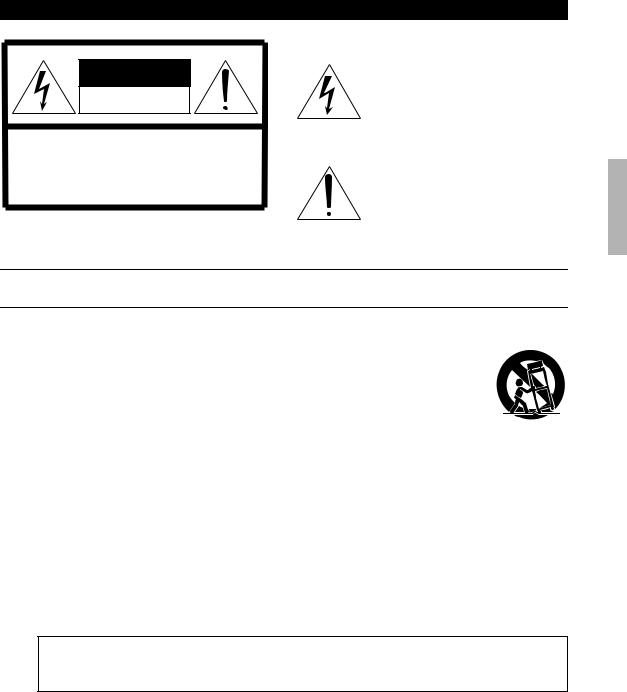
For the AC adaptor
CAUTION
RISK OF ELECTRIC SHOCK
DO NOT OPEN
CAUTION: TO REDUCE THE RISK OF ELECTRIC SHOCK, DO NOT REMOVE COVER (OR BACK). NO USER-SERVICEABLE PARTS INSIDE. REFER SERVICING TO QUALIFIED SERVICE PERSONNEL.
Explanation of Graphical Symbols
The lightning flash with arrowhead symbol within an equilateral triangle is intended to alert the user to the presence of uninsulated “dangerous voltage” within the product’s enclosure that may be of sufficient magnitude to constitute a risk of electric shock to persons.
The exclamation point within an equilateral triangle is intended to alert the user to the presence of important operating and maintenance (servicing) instructions in the literature accompanying the product.
IMPORTANT SAFETY INSTRUCTIONS
1Read these instructions.
2Keep these instructions.
3Heed all warnings.
4Follow all instructions.
5Do not use this apparatus near water.
6Clean only with dry cloth.
7Do not block any ventilation openings. Install in accordance with the manufacturer’s instructions.
8Do not install near any heat sources such as radiators, heat registers, stoves, or other apparatus (including amplifiers) that produce heat.
9Do not defeat the safety purpose of the polarized or grounding-type plug. A polarized plug has two blades with one wider than the other. A grounding type plug has two blades and a third grounding prong. The wide blade or the third prong are provided for your safety. If the provided plug does not fit into your outlet, consult an electrician for replacement of the obsolete outlet.
10Protect the power cord from being walked on or pinched particularly at plugs, convenience receptacles, and the point where they exit from the apparatus.
11Only use attachments/accessories specified by the manufacturer.
12Use only with the cart, stand, tripod, bracket, or table specified by the manufacturer, or sold with the apparatus. When a cart is
used, use caution when moving the cart/apparatus combination to avoid injury from tip-over.
13Unplug this apparatus during lightning storms or when unused for long periods of time.
14Refer all servicing to qualified service personnel. Servicing is required when the apparatus has been damaged in any way, such as power-supply cord or plug is damaged, liquid has been spilled or objects have fallen into the apparatus, the apparatus has been exposed to rain or moisture, does not operate normally, or has been dropped.
WARNING
TO REDUCE THE RISK OF FIRE OR ELECTRIC SHOCK, DO NOT EXPOSE THIS APPARATUS TO RAIN OR MOISTURE.
(UL60065_03)
CLP-785, CLP-775, CLP-745, CLP-735, CLP-795GP, CLP-765GP Owner’s Manual 3

PRECAUTIONS
PLEASE READ CAREFULLY BEFORE PROCEEDING
Please keep this manual in a safe and handy place for future reference.
For the AC adaptor
 WARNING
WARNING
•This AC adaptor is designed for use with only Yamaha electronic instruments. Do not use for any other purpose.
•Indoor use only. Do not use in any wet environments.
 CAUTION
CAUTION
•When setting up, make sure that the AC outlet is easily accessible. If some trouble or malfunction occurs, immediately turn off the power switch of the instrument and disconnect the AC adaptor from the outlet. When the AC adaptor is connected to the AC outlet, keep in mind that electricity is flowing at the minimum level, even if the power switch is turned off. When you are not using the instrument for a long time, make sure to unplug the power cord from the wall AC outlet.
For the instrument
 WARNING
WARNING
Always follow the basic precautions listed below to avoid the possibility of serious injury or even death from electrical shock, short-circuiting, damages, fire or other hazards. These precautions include, but are not limited to, the following:
|
|
|
Power supply/AC adaptor |
Water warning |
•Do not place the power cord near heat sources such as heaters or radiators. Also, do not excessively bend or otherwise damage the cord, or place heavy objects on it.
•Only use the voltage specified as correct for the instrument. The required voltage is printed on the name plate of the instrument.
•Use the specified adaptor (page 136 or page 138) only. Using the wrong adaptor can result in damage to the instrument or overheating.
•Use only the supplied power cord/plug.
•Check the electric plug periodically and remove any dirt or dust which may have accumulated on it.
Do not open
•This instrument contains no user-serviceable parts. Do not open the instrument or attempt to disassemble or modify the internal components in any way. If it should appear to be malfunctioning, discontinue use immediately and have it inspected by qualified Yamaha service personnel.
•Do not expose the instrument to rain, use it near water or in damp or wet conditions, or place on it any containers (such as vases, bottles or glasses) containing liquids which might spill into any openings. If any liquid such as water seeps into the instrument, turn off the power immediately and unplug the power cord from the AC outlet. Then have the instrument inspected by qualified Yamaha service personnel.
•Never insert or remove an electric plug with wet hands.
Fire warning
•Do not put burning items, such as candles, on the unit. A burning item may fall over and cause a fire.
Influences on electro-medical devices (if Bluetooth functionality is included)
(For information on whether Bluetooth functionality is included or not, refer to page 142.)
•Radio waves may affect electro-medical devices.
-Do not use this product near medical devices or inside areas in which the use of radio waves is restricted.
-Do not use this product within 15cm (6 in.) of persons with a heart pacemaker or defibrillator implant.
DMI-7 1/3
4 CLP-785, CLP-775, CLP-745, CLP-735, CLP-795GP, CLP-765GP Owner’s Manual

Using the bench (If included)
•Do not place the bench in an unstable position where it might accidentally fall over.
•Do not play carelessly with or stand on the bench. Using it as a tool or stepladder or for any other purpose might result in accident or injury.
•Only one person should sit on the bench at a time, in order to prevent the possibility of accident or injury.
•If the bench screws become loose due to extensive long-term use, tighten them periodically using the specified tool in order to prevent the possibility of accident or injury.
•Keep special watch over any small children so that they don’t fall off the rear of the bench. Since the bench does not have a backrest, unsupervised use may result in accident or injury.
 CAUTION
CAUTION
If you notice any abnormality
•When one of the following problems occur, immediately turn off the power switch and disconnect the electric plug from the outlet. Then have the device inspected by Yamaha service personnel.
-The power cord or plug becomes frayed or damaged.
-It emits unusual smells or smoke.
-Some object has been dropped into the instrument.
-There is a sudden loss of sound during use of the instrument.
-If any cracks or breakages exist on the instrument.
Always follow the basic precautions listed below to avoid the possibility of physical injury to you or others, or damage to the instrument or other property. These precautions include, but are not limited to, the following:
Power supply/AC adaptor
•Do not connect the instrument to an electrical outlet using a multipleconnector. Doing so can result in lower sound quality, or possibly cause overheating in the outlet.
•When removing the electric plug from the instrument or an outlet, always hold the plug itself and not the cord. Pulling by the cord can damage it.
•Remove the electric plug from the outlet when the instrument is not to be used for extended periods of time, or during electrical storms.
Assembly
•Assemble the instrument in the proper sequence by following the assembly instructions in this manual. Also, make sure to tighten the screws regularly. Failure to do so might result in damage to the instrument or even injury.
•When setting up the product, make sure that the AC outlet you are using is easily accessible. If some trouble or malfunction occurs, immediately turn off the power switch and disconnect the plug from the outlet. Even when the power switch is turned off, electricity is still flowing to the product at the minimum level. When you are not using the product for a long time, make sure to unplug the power cord from the wall AC outlet.
Connections
•Before connecting the instrument to other electronic components, turn off the power for all components. Before turning the power on or off for all components, set all volume levels to minimum.
•Be sure to set the volumes of all components at their minimum levels and gradually raise the volume controls while playing the instrument to set the desired listening level.
Location
•Do not place the instrument in an unstable position where it might accidentally fall over.
•Do not go near the instrument during an earthquake. Strong shaking during an earthquake could cause the instrument to move or tip over, resulting in damage to the instrument or its parts, and possibly causing injury.
•(CLP-785, CLP-775, CLP-745, CLP-735) When transporting or moving the instrument, always use two or more people. Attempting to lift the instrument by yourself may damage your back, result in other injury, or cause damage to the instrument itself.
•(CLP-795GP, CLP-765GP) Since this product is very heavy, make sure that a sufficient number of people are on hand to help, so you can lift and move it safely and easily. Attempting to lift or move the instrument by force may damage your back, result in other injury, or cause damage to the instrument itself.
•Before moving the instrument, remove all connected cables, to prevent damage to the cables or injury to anyone who might trip over them.
Handling caution
•Do not insert a finger or hand in any gaps on the key cover or instrument. Also take care that the key cover does not pinch your finger.
•Never insert or drop paper, metallic, or other objects into the gaps on the key cover, panel or keyboard. This could cause physical injury to you or others, damage to the instrument or other property, or operational failure.
•(CLP-785) Do not apply excessive force when closing the key cover. A key cover equipped with the SOFT-CLOSE™ mechanism closes the cover slowly. Applying excessive force to the key cover when closing it could damage the SOFT-CLOSE™ mechanism, and possibly result in injury to your hands and fingers caught under the closing key cover.
•Do not rest your weight on, or place heavy objects on the instrument, and do not use excessive force on the buttons, switches or connectors.
•Keep small parts out of the reach of infants. Your children may accidentally swallow them.
DMI-7 2/3
CLP-785, CLP-775, CLP-745, CLP-735, CLP-795GP, CLP-765GP Owner’s Manual 5
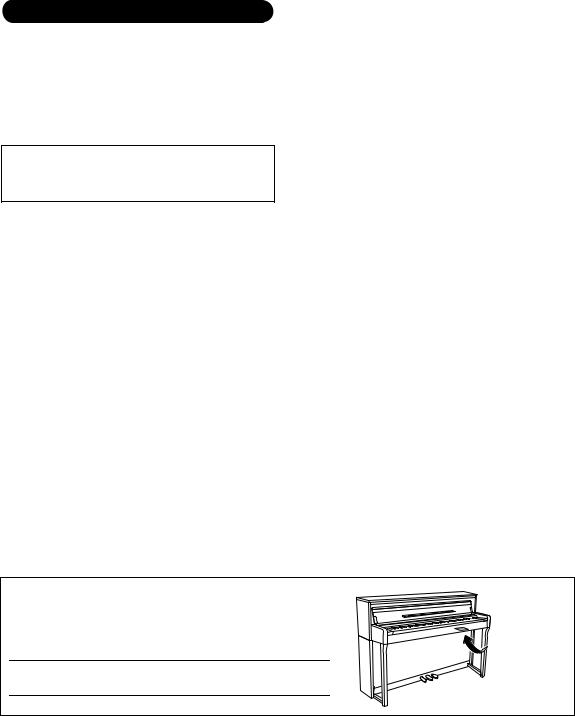
•Do not use the instrument/device or headphones for a long period of time at a high or uncomfortable volume level, since this can cause permanent hearing loss. If you experience any hearing loss or ringing in the ears, consult a physician.
Using the bench (If included)
•For benches that can be adjusted, do not adjust the bench height while sitting on the bench, since this can cause excessive force to be imposed on the adjustment mechanism, possibly resulting in damage to the mechanism or even injury.
•Do not place your hand between moving parts. Otherwise, your hand could be pinched between the parts, possibly resulting in injury.
Yamaha cannot be held responsible for damage caused by improper use or modifications to the instrument, or data that is lost or destroyed.
Always turn the power off when the instrument is not in use.
Even when the [  ] (Standby/On) switch is in standby status (power lamp is off), electricity is still flowing to the instrument at the minimum level. When you are not using the instrument for a long time, make sure you unplug the power cord from the wall AC outlet.
] (Standby/On) switch is in standby status (power lamp is off), electricity is still flowing to the instrument at the minimum level. When you are not using the instrument for a long time, make sure you unplug the power cord from the wall AC outlet.
The model number, serial number, power requirements, etc., may be found on or near the name plate, which is at the bottom of the unit. You should note this serial number in the space provided below and retain this manual as a permanent record of your purchase to aid identification in the event of theft.
Model No.
Serial No.
DMI-7 3/3
6 CLP-785, CLP-775, CLP-745, CLP-735, CLP-795GP, CLP-765GP Owner’s Manual
The name plate is located on the bottom of the unit.
(bottom_en_01)

NOTICE
To avoid the possibility of malfunction/ damage to the product, damage to data, or damage to other property, follow the notices below.
Handling
•Do not connect this product to public Wi-Fi and/or Internet directly. Only connect this product to the Internet through a router with strong password-protections. Consult your router manufacturer for information on security best practices.
•Do not use the instrument in the vicinity of a TV, radio, stereo equipment, mobile phone, or other electric devices. Otherwise, the instrument, TV, or radio may generate noise. When you use the instrument along with an application on your smart device such as a smartphone or tablet, we recommend that you set Wi-Fi or Bluetooth to on after setting “Airplane Mode” to on on that device in order to avoid noise caused by communication.
•Do not expose the instrument to excessive dust or vibrations, or extreme cold or heat (such as in direct sunlight, near a heater, or in a car during the day) to prevent the possibility of panel disfiguration, damage to the internal components or unstable operation. (Verified operating temperature range: 5° – 40°C, or 41° – 104°F.)
•Do not place vinyl, plastic or rubber objects on the instrument, since this might discolor the panel or keyboard.
•In the case of a model with a polished finish, bumping the surface of the instrument with metal, porcelain, or other hard objects can cause the finish to crack or peel. Use caution.
Maintenance
•When cleaning the instrument, use a soft and dry/slightly damp cloth. Do not use paint thinners, solvents, alcohol, cleaning fluids, or chemical-impregnated wiping cloths.
•In the case of a model with a polished finish, gently remove dust and dirt with a soft cloth. Do not wipe too hard since small particles of dirt can scratch the instrument’s finish.
•During extreme changes in temperature or humidity, condensation may occur and water may collect on the surface of the instrument. If water is left, the wooden parts may absorb the water and be damaged. Make sure to wipe any water off immediately with a soft cloth.
Saving data
•Some of the data of this instrument (page 104) and the Song data saved to the internal memory of this instrument
(page 54) are retained when the power is turned off. However, the saved data may be lost due to some failure, an operation mistake, etc. Save your important data onto USB flash drive or an external device such as a computer (page 76). Before using a USB flash drive, make sure to refer to page 74.
•To protect against data loss through USB flash drive damage, we recommend that you save your important data onto spare USB flash drive or an external device such as a computer as backup data.
Information
About copyrights
•Copying of the commercially available musical data including but not limited to MIDI data and/or audio data is strictly prohibited except for your personal use.
•This product incorporates and bundles contents in which Yamaha owns copyrights or with respect to which Yamaha has license to use others’ copyrights. Due to copyright laws and other relevant laws, you are NOT allowed to distribute media in which these contents are saved or recorded and remain virtually the same or very similar to those in the product.
*The contents described above include a computer program, Accompaniment Style data, MIDI data, WAVE data, voice recording data, a score, score data, etc.
*You are allowed to distribute medium in which your performance or music production using these contents is recorded, and the permission of Yamaha Corporation is not required in such cases.
About functions/data bundled with the
instrument
•Some of the preset songs have been edited for length or arrangement, and may not be exactly the same as the original.
•This device is capable of using various types/formats of music data by optimizing them to the proper format music data for use with the device in advance. As a result, this device may not play them back precisely as their producers or composers originally intended.
•The bitmap fonts used in this instrument have been provided by and are the property of Ricoh Co., Ltd.
About this manual
•The illustrations and LCD screens as shown in this manual are for instructional purposes only, and may appear somewhat different from those on your instrument.
•Windows is a registered trademark of Microsoft® Corporation in the United States and other countries.
•iPhone, iPad are trademarks of Apple Inc., registered in the U.S. and other countries.
•The letters at the end of the model name (such as “B,” “WA”) indicate the color or finish of the instrument. Since they simply indicate the appearance, these letters are omitted in this manual.
•The Bluetooth® word mark and logos are registered trademarks owned by Bluetooth SIG, Inc. and any use of such marks by Yamaha Corporation is under license.
•The company names and product names in this manual are the trademarks or registered trademarks of their respective companies.
Tuning
•Unlike an acoustic piano, this instrument does not need to be tuned by an expert (although the pitch can be user-adjusted to match other instruments). This is because the pitch of digital instruments is always maintained perfectly.
CLP-785, CLP-775, CLP-745, CLP-735, CLP-795GP, CLP-765GP Owner’s Manual 7
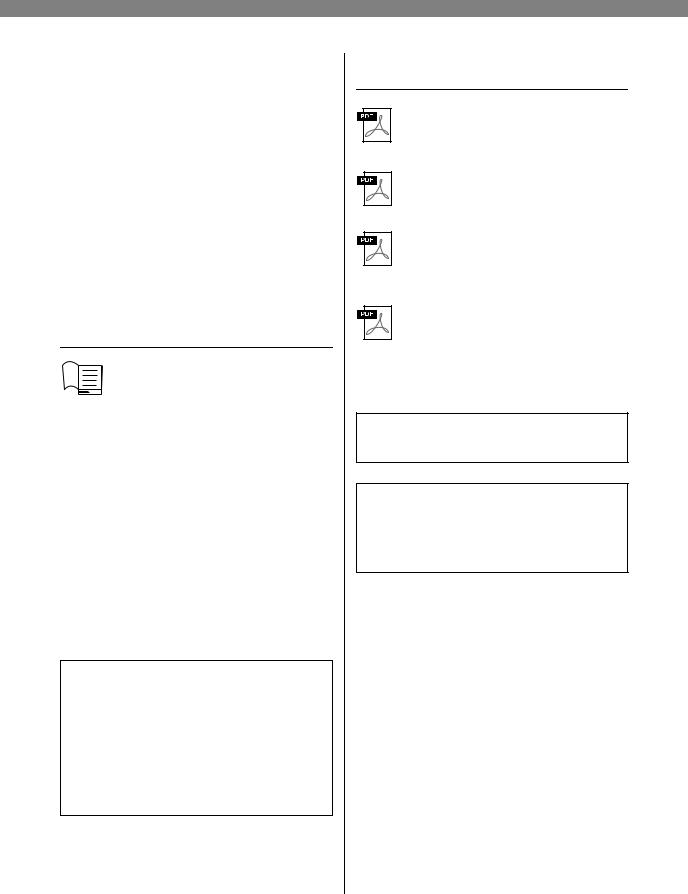
Included Accessories
Owner’s Manual (this book)
“50 Classical Music Masterpieces” (Music Book)
Online Member Product Registration
Power cord*, AC adaptor*
Bench*
Warranty*
*May not be included depending on your area. Check with your Yamaha dealer.
About the Manuals
This instrument has the following documents and instructional materials.
Included Documents
Owner’s Manual (this book)
This document explains how to use the
Clavinova.
• Introduction:
This section explains how to set up and start using your Clavinova. Setup is so simple, you can start playing right away.
• Main Operations:
This section explains various functions useful for your practice, such as Preset Song playback and Song recording.
• Detailed Settings:
This section explains how to make detailed settings for the Clavinova’s various functions. Refer to this section as necessary.
• Appendix:
This section introduces Message List, a description of Preset Voices, and other reference material.
Icons on this manual
Example:
785 |
775 |
745 |
735 |
795GP |
765GP |
This indicates that the relevant function is only available on certain models. These icons indicate that the function is available on the CLP-785 but not on the CLP-775, CLP-745, CLP-735, CLP-795GP or CLP-765GP.
Online Materials (Downloadable from the web)
Data List (CLP-785 and CLP-795GP only)
This document contains lists of XG Voices and XG Drum Kit that can be selected on the CLP-785 and CLP-795GP.
Smart Device Connection Manual
Explains how to connect the instrument to a smart device such as smartphone or tablet, etc.
Computer-related Operations
Includes instructions on connecting this instrument to a computer, and operations related to transferring song data.
MIDI Reference
Contains the MIDI-related information.
To obtain these manuals, access the Yamaha Downloads, enter the model name for searching the desired files.
Yamaha Downloads https://download.yamaha.com/
Smart Device App “Smart Pianist”
Enjoy easy operation by connecting your smart device. To use this, you’ll need to install the “Smart Pianist” app (free for download). For details, refer to “Using a Smart Device App” on page 80.
8 CLP-785, CLP-775, CLP-745, CLP-735, CLP-795GP, CLP-765GP Owner’s Manual

Table of Contents |
|
PRECAUTIONS .................................................... |
4 |
NOTICE ...................................................................... |
7 |
Information ................................................................ |
7 |
Included Accessories .................................................. |
8 |
About the Manuals ..................................................... |
8 |
Features ..................................................................... |
10 |
Introduction |
12 |
Panel Controls and Terminals ................................. |
12 |
Getting Started — Playing the Clavinova ................ |
15 |
Turning the Power On or Off ............................................. |
15 |
Music Rest ............................................................................. |
18 |
Lid ........................................................................................... |
20 |
Setting the Volume — [MASTER VOLUME] .................. |
21 |
Using Headphones ............................................................... |
21 |
Using the Pedals .................................................................... |
23 |
Basic Operations ....................................................... |
24 |
Main Operations |
26 |
Enjoying the Piano Performance ............................. |
26 |
Selecting two Grand Piano Voices from the panel directly 26 |
|
Customizing the Sound and the Touch Response of Piano |
|
Voices (Piano Room) ........................................................... |
27 |
Playing Various Musical Instrument Sounds (Voices) 30 |
|
Selecting Voices .................................................................... |
30 |
Listening to the Voice Demos ............................................. |
32 |
Enhancing and Customizing the Sound ............................ |
33 |
Playing Two Voices Simultaneously (Dual) ..................... |
35 |
Splitting the Keyboard Range and Playing Two Different |
|
Voices (Split Mode) .............................................................. |
36 |
Using Dual and Split Simultaneously ................................ |
37 |
Playing Duo ........................................................................... |
38 |
Using the Metronome .......................................................... |
39 |
Playing the Keyboard along with Rhythm Playback 42
Playing Back Songs ................................................... |
43 |
Song Playback ....................................................................... |
44 |
Playing a One-hand Part — Part Cancel Function |
|
(MIDI Songs) ........................................................................ |
48 |
Playing Back a Song Repeatedly ......................................... |
49 |
Adjusting the Volume Balance ........................................... |
52 |
Useful Playback Functions .................................................. |
53 |
Recording Your Performance .................................. |
54 |
Recording Methods .............................................................. |
54 |
Quick MIDI Recording ........................................................ |
55 |
MIDI Recording — Independent Tracks .......................... |
57 |
MIDI Recording to the USB Flash Drive .......................... |
59 |
Audio Recording to the USB Flash Drive ......................... |
60 |
Other Recording Techniques .............................................. |
61 |
Handling Song Files ................................................. |
65 |
Basic Song File Operation ................................................... |
66 |
Deleting Files — Delete ....................................................... |
67 |
Copying Files — Copy ......................................................... |
68 |
Moving Files — Move ......................................................... |
68 |
Convert a MIDI Song to an Audio Song during Playback — |
|
MIDI to Audio ...................................................................... |
69 |
Renaming Files — Rename ................................................. |
70 |
Connections .............................................................. |
71 |
Connectors ............................................................................ |
71 |
Connecting to an Audio Player ([AUX IN] jack) ............ |
72 |
Using an External Speaker System for Playback |
|
(AUX OUT [L/L+R]/[R] jacks) .......................................... |
73 |
Connecting USB Devices (USB [TO DEVICE] Terminal) |
|
................................................................................................. |
74 |
Connecting External MIDI Devices (MIDI Terminals) . 75 |
|
Connecting to a Computer (USB [TO HOST] Terminal) |
|
................................................................................................. |
76 |
Connecting to a Smart Device ............................................ |
77 |
Using a Smart Device App .................................................. |
80 |
Detailed Settings (Menu Display) |
86 |
Common Operations in the Menu Displays ............ |
86 |
Voice Menu ............................................................... |
87 |
Song Menu ................................................................ |
92 |
Metronome/Rhythm Menu ...................................... |
95 |
Recording Menu ....................................................... |
96 |
System Menu ............................................................. |
97 |
Appendix |
106 |
Preset Voice List ..................................................... |
106 |
Song List ................................................................. |
109 |
Rhythm List ............................................................ |
110 |
Message List ............................................................ |
111 |
Troubleshooting ..................................................... |
113 |
Assembling the Clavinova ...................................... |
115 |
Specifications .......................................................... |
134 |
Index ....................................................................... |
140 |
About Bluetooth ..................................................... |
142 |
For information on whether Bluetooth functionality is included or not, refer to page 142.
CLP-785, CLP-775, CLP-745, CLP-735, CLP-795GP, CLP-765GP Owner’s Manual 9

Features
Full-scale piano performance
GrandTouch Keyboard and GrandTouch-S Keyboard
The CLP-700 series models feature a special keyboard, which remarkably reproduces the authentic touch and feel of an actual grand piano. Its mechanism provides exceptionally expressive control from pianissimo to fortissimo. Moreover, the keys of the GrandTouch Keyboard (CLP-785, CLP-775 and CLP-795GP) have a long pivot point distance (length from the front side to the pivot point), for a more natural feeling, even when playing the inner part of a key.
Two world-renowned concert grand pianos
 page 26
page 26
All models feature piano sounds created with samples of the Yamaha CFX flagship concert grand piano and the famed Vienna-made Bösendorfer grand piano. The sound of the Yamaha CFX is powerful, sparkling and with a rich bass resonance. On the other hand, the Bösendorfer sound is soft and deep in the mid to bass range and beautiful for pianissimo parts. You can select the one that best matches the music you want to play.
* Bösendorfer is a subsidiary company of Yamaha.
Piano Room feature for adjusting touch and resonance
 page 27
page 27
From the Piano Room displays, you can adjust various parameters such as string resonance and touch response. You can also listen to the demo for VRM, which reproduces luxurious string and soundboard resonance, and the demo for Grand Expression Modeling, which recreates the subtle changes in the sound that respond to your touch.
• VRM effect for reproducing the distinctive reverberation of a grand piano
The VRM function on all models simulates the luscious resonance effect on acoustic pianos—where the sound of one string causes sympathetic vibration in other strings and the soundboard. You can vary the sound expressively by changing the timing of your pressing the keys, and the timing and depth of your pressing the pedal.
• Grand Expression Modeling for superbly expressive sound
On an actual acoustic piano, subtle changes in the sound can be produced by changing your playing touch from when you press a key to when you release it. The Grand Expression Modeling technology recreates these subtle changes in the sound that respond to your touch. This allows you to add accents by playing strongly or add resonance by playing softly to produce superbly expressive sound.
Realistic feeling of being immersed in the sound —even when using headphones
 page 22
page 22
When headphones are connected, the sounds of the CFX and Bösendorfer automatically switch to binaural sampling sound—which gives the impression of being immersed in the sound, as if it was actually emanating from the piano. When other piano Voices are selected, the Stereophonic Optimizer effect reproduces a natural sound distance.
10 CLP-785, CLP-775, CLP-745, CLP-735, CLP-795GP, CLP-765GP Owner’s Manual
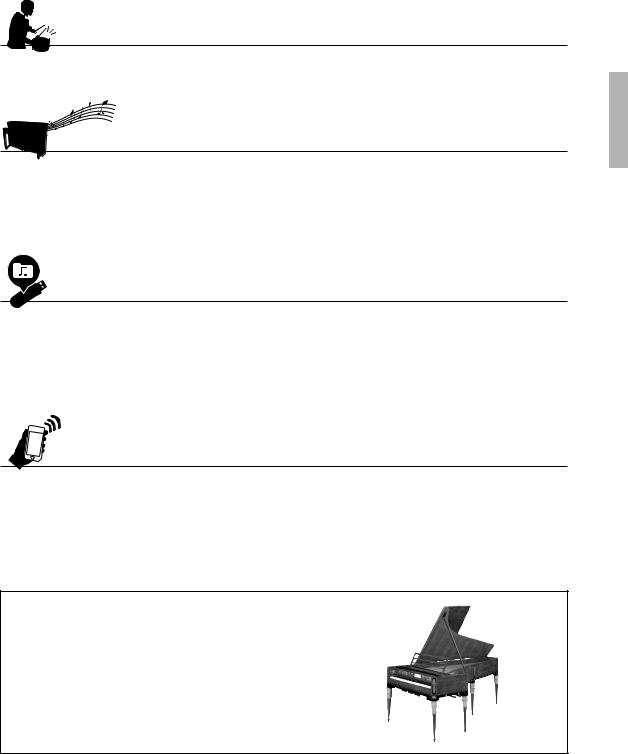
Convenient performance functions
Rhythm Tracks
 page 42
page 42
All models feature twenty different simple rhythm patterns (drums and bass accompaniment) that are perfectly suited to many types of music regularly performed on the piano, for even greater performance potential.
Preset Songs for effective practicing
 page 43
page 43
Also built into this instrument are 50 classical music masterpieces, plus 303 lesson Songs for mastering the piano. You can simply enjoy listening to these built-in Songs, or use them for separate right-hand/left-hand practicing.* The 303 lesson Songs consist of practice pieces taken from various standard piano instruction manuals, including “The Virtuoso Pianist.”
*The part on/off function is available only for MIDI songs that have both rightand left-hand parts.
Two recording methods
 page 54
page 54
The instrument lets you save your performance to internal memory or a USB flash drive (sold separately). You can record your performance using one of two methods, MIDI or Audio recording, according to your needs. MIDI recording is ideal for making independent tracks—for example, recording a right-hand part to Track 1 first, and then a left-hand part to Track 2—allowing you to create pieces that would be difficult to play live with both hands together. Audio recording on the other hand, saves recorded data in stereo, CD-quality WAV format to a USB flash drive, for storing to computer and playing on portable music players.
Connecting to a Smart Device
 page 77
page 77
By connecting this instrument to a smart device such as smart phone or tablet, you can enjoy compatible smart device apps. In addition, you can input the audio from a smart device to this instrument via Bluetooth* and hear it through the built-in speakers of the instrument.
*The models CLP-785, CLP-775, CLP-745, CLP-795GP and CLP-765GP are equipped with Bluetooth functionality; however, even these models may not support Bluetooth, depending on the country in which you purchased the product. For details, refer to page 142.
Fortepiano Voices—authentic classical period piano sounds
All models feature authentic sounds created with samples of actual fortepianos—pianos which were made in the era of Mozart, Beethoven and Chopin. Enjoy performing with the actual sounds used in the era that classical music masterpieces were composed. Refer to page 30 for selecting Voices.
*The fortepiano shown in the picture is from the collection of at the
Hamamatsu Museum of Musical Instruments.
CLP-785, CLP-775, CLP-745, CLP-735, CLP-795GP, CLP-765GP Owner’s Manual 11
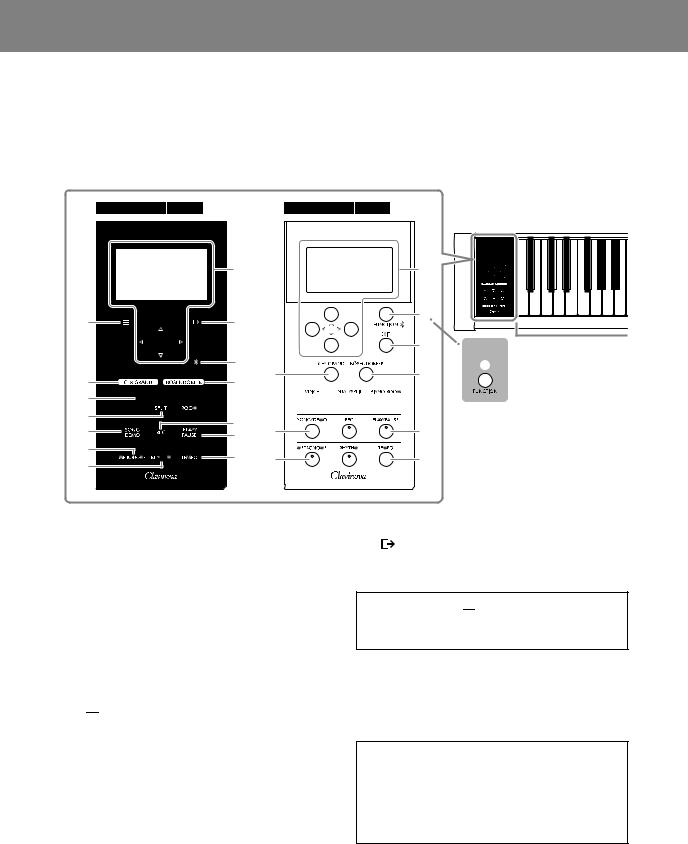
Introduction
Panel Controls and Terminals
On the CLP-785/775/795GP, the control panel lights up when the power is turned on, and you can control it by pressing the panel indications or icons. Be sure to read “Turning the Power On or Off” on page 15, then turn on the power and check the panel.
Control Panel (page 24)
785 |
775 |
795GP |
745 |
735 |
765GP |
|
3 |
3 |
|
|
|
4 |
A-1 B-1 C0 D0 E0 F0 G0 A0 B0 |
4 |
5 |
|
|
|
|
||
|
|
5 |
CLP-735 |
|
|
|
|
|
6 |
|
4 |
|
7 |
8 |
|
7 |
|
||
8 |
|
|
9






 ! 9
! 9 )
)
 !
!
) |
# |
|
|
|
|
@ |
@ |
# |
$ |
||
$ |
|||||
|
|
|
|
||
% |
& |
% |
^ |
& |
|
^ |
|||||
|
|
|
|
1 [P] (Standby/On) switch.................... |
page 16 |
For turning the power on or setting it to standby.
2 |
[MASTER VOLUME] slider ............... |
page 21 |
|
For adjusting the overall volume. |
|
3 |
[u]/[d]/[<]/[>] buttons, display......... |
page 24 |
For selecting an item or setting a value using the buttons corresponding to the display indication. You cannot operate the display directly by pressing it with your finger.
4 [  ]/[FUNCTION] button ................. page 86
]/[FUNCTION] button ................. page 86
Pressing this button alternates the displays among the menus: “Voice,” “Song,” “Metronome/Rhythm,” “Recording” and “System”—from which you can make detailed settings for the related functions. With the CLP-745 and CLP-765GP, this is also used for connecting to a Bluetooth-equipped device such as a smart device (page 78).
5 [ ]/[EXIT] button ............................ |
page 25 |
Pressing this button exits from the current display, or returns to the Voice or Song display.
In this manual, the [  ] button is hereafter referred to as the [FUNCTION] button, and the [
] button is hereafter referred to as the [FUNCTION] button, and the [  ] button is referred to as the [EXIT] button.
] button is referred to as the [EXIT] button.
6 [  ](Bluetooth) button (CLP-785/775/795GP)
](Bluetooth) button (CLP-785/775/795GP)
............................................................. page 78
Used for connecting to a Bluetooth-equipped device such as a smart device.
Bluetooth capability
Depending on the country in which you purchased the product, the instrument may not have Bluetooth capability. If the Bluetooth logo is shown or printed on the control panel, this means that the product is equipped with Bluetooth functionality.
12 CLP-785, CLP-775, CLP-745, CLP-735, CLP-795GP, CLP-765GP Owner’s Manual

Panel Controls and Terminals
 1
1

 2
2
C1 |
D1 |
E1 |
F1 |
G1 |
A1 |
B1 |
C2 |
D2 |
E2 |
F2 |
G2 |
A2 |
B2 |
C3 |
D3 |
E3 |
F3 |
G3 |
A3 |
B3 |
C4 |
D4 |
E4 |
F4 |
G4 |
A4 |
B4 |
C5 |
D5 |
E5 |
F5 |
G5 |
A5 |
B5 |
C6 |
D6 |
E6 |
F6 |
G6 |
A6 |
B6 |
C7 |
Each key has a note name; for example, the lowest (farthest left) key on the keyboard corresponds to A-1, and the highest (farthest right) key to C7.
7 |
[CFX GRAND] button........................ |
page 26 |
|
For selecting the “CFX Grand” Voice. |
|
8 |
[BÖSENDORFER] button .................. |
page 26 |
|
For selecting the “Bösendorfer” Voice. |
|
9 |
[VOICE] button .................................. |
page 30 |
|
Calls up the Voice group list display. |
|
) [DUAL/SPLIT] button ........... pages 35, 36, 37
For playing two Voices simultaneously, or different Voices on the leftand right-hand sections of the keyboard.
! [PIANO ROOM] button ..................... page 27
Calls up the Piano Room display where you can select an optimum piano sound and adjust the touch response.
@ [SONG/DEMO] button ...................... |
page 43 |
Calls up Song List for selecting a demo Song or a Song to playback or edit.
# [REC] button....................................... |
page 54 |
For recording your keyboard performance. |
|
$ [PLAY/PAUSE] button........................ |
page 44 |
For alternately playing back and pausing the Preset Songs or your recorded material.
% [METRONOME] button..................... |
page 39 |
For using the metronome functions. |
|
^ [RHYTHM] button............................. |
page 42 |
For using the rhythm functions. |
|
& [TEMPO] button ................................ |
page 39 |
For setting the tempo. |
|
See the next page for overall views of the instruments, and their jacks and terminals.
CLP-785, CLP-775, CLP-745, CLP-735, CLP-795GP, CLP-765GP Owner’s Manual 13
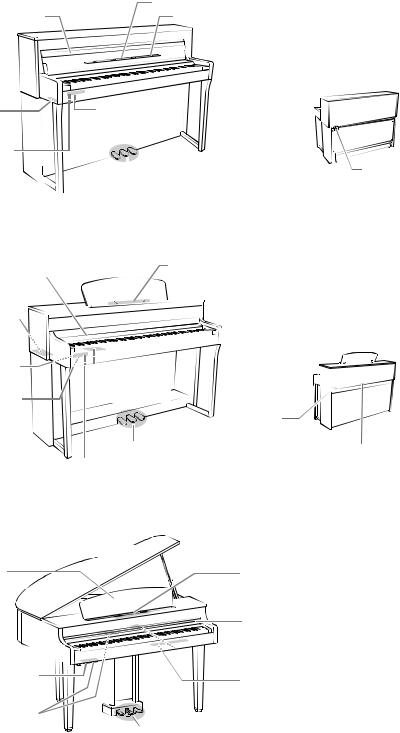
Panel Controls and Terminals
Overall views, jacks and terminals
CLP-785
|
Music rest (page 18) |
Key cover (page 15) |
Music braces (page 18) |
[PHONES] |
|
|
|
|
Terminal panel |
|||
|
|
|
||||||
jacks |
||||||||
(page 71) |
||||||||
(page 21) |
||||||||
|
|
|
||||||
USB |
|
|
|
|||||
[TO DEVICE] |
|
|
|
|||||
terminal |
|
|
|
|||||
(page 74) |
Pedals (page 23) |
|||||||
|
|
|
|
|
||||
CLP-775, 745, 735 |
Music rest (page 19) |
|||||||
Key cover |
|
|
Music braces |
|||||
|
|
|||||||
(page 15) |
|
|
(page 19) |
|||||
(CLP-775) |
|
|
|
|||||
|
|
|
||||||
Terminal panel |
|
|
|
|||||
(page 71) |
|
|
|
|||||
USB [TO DEVICE] terminal (page 74)
Terminal panel (page 71)
 (CLP-745, 735) Terminal panel (page 71)
(CLP-745, 735) Terminal panel (page 71)
Pedals (page 23)
[PHONES] jacks (page 21)
(CLP-775) DC IN jack (page 15)
DC IN jack (page 15)
(CLP-745, 735)
DC IN jack (page 15)
CLP-795GP, 765GP
Music rest (page 19)
[PHONES] jacks (page 21)
(CLP-765GP) Terminal panels (page 71)
 Lid (page 20)
Lid (page 20)
Music braces (page 19)
Key cover (page 15)
 DC IN jack (page 15)
DC IN jack (page 15)
(CLP-795GP)
Terminal panel (page 71)
Pedals (page 23)
14 CLP-785, CLP-775, CLP-745, CLP-735, CLP-795GP, CLP-765GP Owner’s Manual

Getting Started — Playing the Clavinova
This section explains how to set up and start using your Clavinova. Setup is so simple, you can start playing right away.
Turning the Power On or Off
1. Connect the plugs of the AC adaptor in the order shown in the illustration.
785 |
775 |
745 |
735 |
795GP |
765GP |
|
DC IN jack (page 14) |
|
|
||
1-2 |
DC plug |
1-3 |
|
||
|
|
|
|
|
1-1 |
|
|
Power cord |
|
AC |
|
|
adaptor |
AC plug |
|
|
AC outlet
The shape of the plug and outlet differ depending on your locale.
785 |
775 |
745 |
735 |
795GP |
765GP |
|
DC IN jack (page 14) |
|
|
||
1-2 |
|
DC plug |
1-3 |
|
|
||
|
|
|
|
|
|
|
1-1 |
|
|
|
|
|
|
|
AC outlet |
|
Power cord |
The shape of the plug and |
|
AC |
|
||
|
outlet differ depending on |
||
adaptor |
AC plug |
||
your locale. |
|||
|
2. Open the key cover.
785 |
775 |
745 |
735 |
795GP |
765GP |
2-1. With both hands, hold the hand grip, then lift and open the key cover.
2-2. Fold down the top of the key cover.
2-1 |
2-2 |
 CAUTION
CAUTION
Be careful to avoid catching your fingers when opening or closing the cover.
 WARNING
WARNING
Use the specified adaptor (page 136 or page 138) only. Using the wrong AC adaptor can result in damage to the instrument or overheating.
 CAUTION
CAUTION
When setting up the product, make sure that the AC outlet you are using is easily accessible. If some trouble or malfunction occurs, immediately turn the power off and disconnect the plug from the outlet.
NOTE
When disconnecting the power cord/AC adaptor, first turn off the power, then follow this procedure in reverse order.
 CAUTION
CAUTION
•Do not place anything (such as metal objects or pieces of paper) on top of the key cover. Small objects placed on the key cover may fall inside the unit when the cover is opened and may be nearly impossible to remove. Once inside, they could cause electric shock, short circuit, fire or other serious damage to the instrument.
•Hold the cover with both hands when opening or closing it. Do not release it until it is fully opened or closed. Be careful to avoid catching fingers (yours or others, especially children’s) between the cover and the unit.
CLP-785, CLP-775, CLP-745, CLP-735, CLP-795GP, CLP-765GP Owner’s Manual 15
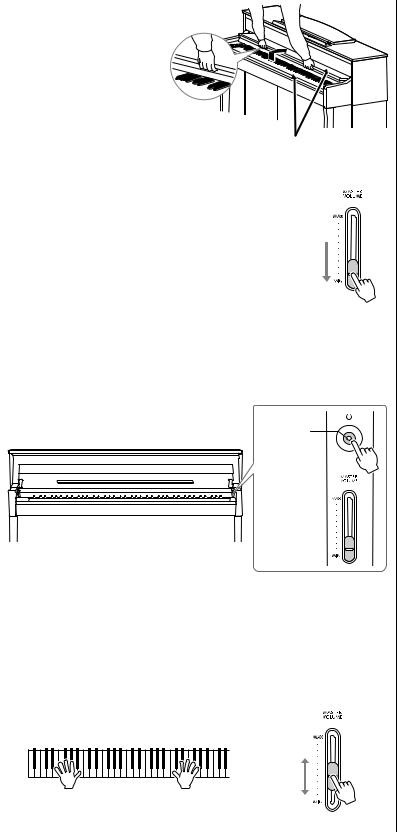
Getting Started — Playing the Clavinova
785 |
775 |
745 |
735 |
795GP |
765GP |
Lift the cover slightly, then push and slide it to the end.
 CAUTION
CAUTION
Be careful to avoid catching your fingers when opening or closing the cover.
3. Turn down the [MASTER VOLUME] slider at the right of the keyboard to “MIN.”
4. Press the [P] (Standby/On) switch at the right of the keyboard to turn the power on.
The display located at the left of the keyboard and the power lamp on the [P] (Standby/On) switch both light up.
The power lamp lights up.
On the CLP-785/775/795GP, the control panel lights up, and automatically turns off if you do not press it for a while. Simply press anywhere on the control panel to turn it on again.
5. Play the keyboard.
While playing the keyboard, adjust the volume level by using the [MASTER VOLUME] slider. For details, refer to “Setting the volume — [MASTER VOLUME]” on page 21.
NOTICE
Press only the [P] (Standby/ On) switch when turning the power on. Any other operations, such as pressing the keys, buttons or pedals may cause the instrument to malfunction.
NOTE
(CLP-785/775/795GP) You can change the time that elapses until the control panel turns off, or you can set it to remain on indefinitely. For details, refer to “Auto Backlight Off” on
page 101.
16 CLP-785, CLP-775, CLP-745, CLP-735, CLP-795GP, CLP-765GP Owner’s Manual
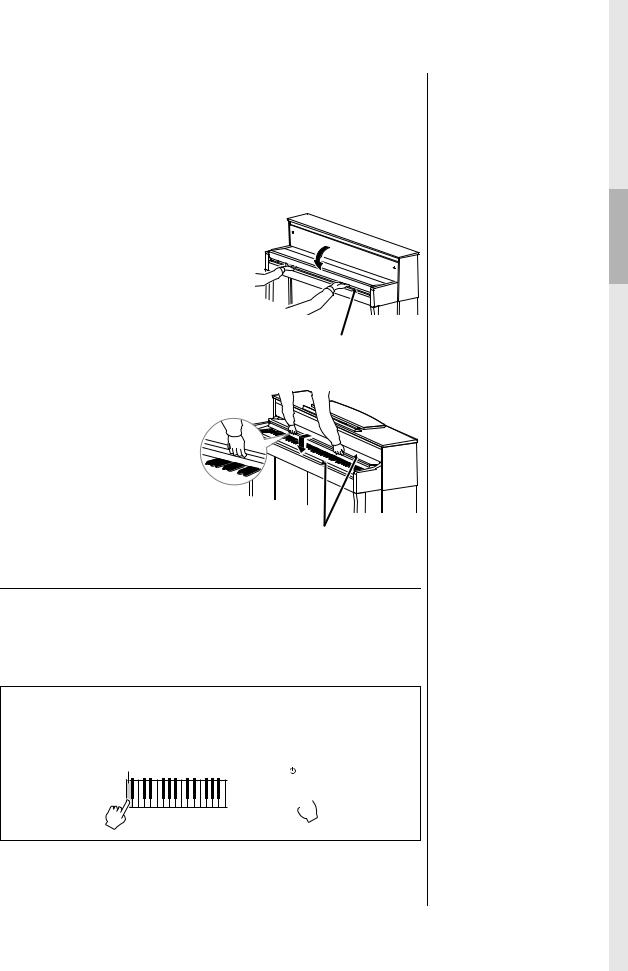
Getting Started — Playing the Clavinova
6. After you use the instrument, press and hold the
[P] (Standby/On) switch for a second to turn the power off.
The power lamp on the [P] (Standby/On) switch is turned off.
7. Close the key cover.
785 |
775 |
745 |
735 |
795GP |
765GP |
7-1. If the music rest is unfolded, fold it back.
7-2. With both hands, open the folded top of the key cover, and close it gently.
The key cover is equipped with the special SOFT-CLOSE™ mechanism which closes the cover slowly.
 CAUTION
CAUTION
Be careful to avoid catching your fingers when opening or closing the cover.
785 |
775 |
745 |
735 |
795GP |
765GP |
Slide the cover toward you and gently lower the cover over the keys.
 CAUTION
CAUTION
Be careful to avoid catching your fingers when opening or closing the cover.
Auto Power Off function
To prevent unnecessary power consumption, this instrument features an Auto Power Off function that automatically turns the power off if the instrument is not operated for a specified period of time. The amount of time that elapses before the power is automatically turned off is approximately 30 minutes by default; however, you can change the setting (page 101).
Disabling Auto Power Off (simple method)
Turn the power on while holding down the lowest key on the keyboard. An “Auto power off disabled” message appears briefly and Auto Power Off is disabled.
The lowest key
+ 

 CAUTION
CAUTION
Even when the [P] (Standby/
On) switch is in standby status, electricity is still flowing to the instrument at the minimum level. Remove the electric plug from the outlet when the instrument is not to be used for extended periods of time, or during electrical storms.
 CAUTION
CAUTION
(CLP-785) Do not apply excessive force when closing the key cover. Applying excessive force to the key cover when closing it could damage the SOFT-CLOSE™ mechanism, and possibly result in injury to your hands and fingers caught under the closing key cover.
NOTICE
•Any data which are not saved will be lost if the power automatically turns off. Make sure to save your data before this happens.
•Depending on the instrument status, the power may not turn off automatically, even after the specified period of time elapses. Always turn off the power manually when the instrument is not in use.
CLP-785, CLP-775, CLP-745, CLP-735, CLP-795GP, CLP-765GP Owner’s Manual 17

Getting Started — Playing the Clavinova
Music Rest
785 |
775 |
745 |
735 |
795GP |
765GP |
Fold down the top of the key cover (see step 2 on page 15) when using the music rest.
Unfold the music rest:
1. Unfold the music rest, which is on the inside of the key cover.
2. Unfold the music braces, which allow you to hold the pages of music books in place.
1 |
Music brace
2
Fold the music rest:
1. Fold the music braces if they are unfolded.
2. Fold the music rest before closing the key cover.
|
Music brace |
2 |
1 |
NOTICE
Do not put anything heavy on the music rest for a long period of time. Doing so may damage the music rest.
18 CLP-785, CLP-775, CLP-745, CLP-735, CLP-795GP, CLP-765GP Owner’s Manual

785 |
775 |
745 |
735 |
795GP |
765GP |
To raise the music rest:
1. Pull the music rest up and toward yourself as far as it will go.
2. Flip down the two metal
supports at the left and right on
Music braces
the rear of the music rest.
3. Lower the music rest so that the metal supports latch into place.
Music braces allow you to hold the pages of music books in place.
To lower the music rest:
Close the Music braces if they are open, and then lower the music rest by following the instructions below.
1. |
Pull the music rest toward |
|
|
yourself as far as it will go. |
Music braces |
|
|
|
2. |
Raise the two metal supports |
|
|
(at the rear of the music rest). |
|
3. |
Gently lower the music rest |
|
|
backward until it is all the way |
|
|
down. |
|
Getting Started — Playing the Clavinova
 CAUTION
CAUTION
Do not try to use the music rest in a half-raised position. Also, when raising or lowering the music rest, do not release your hands from the music rest until it is all the way up or down.
CLP-785, CLP-775, CLP-745, CLP-735, CLP-795GP, CLP-765GP Owner’s Manual 19
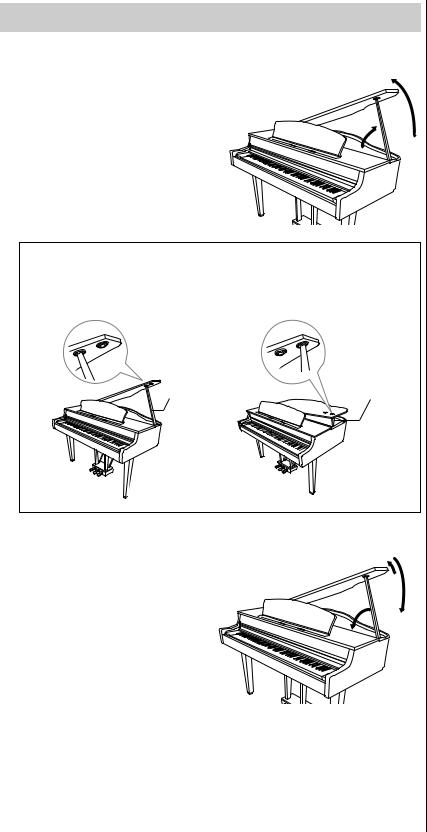
Getting Started — Playing the Clavinova
Lid
785 |
775 |
745 |
735 |
795GP |
765GP |
To open the lid: |
1 |
1. Raise and hold the right side of |
|
the lid (viewed from the |
2 |
keyboard end of the instrument). |
|
2. Raise the lid stay and carefully lower the lid so that the end of the stay fits into the recess in the lid.
785 |
775 |
745 |
735 |
795GP |
765GP |
For the longer stay, use the inner recess, and for the shorter stay, use the outer recess to support the lid.
Longer stay |
Shorter stay |
To close the lid:
1. Hold the lid stay and carefully raise the lid.
2. Hold the lid in its raised position and lower the lid stay.
3. Carefully lower the lid.
1
3
2
 WARNING
WARNING
•Do not let children open or close the lid. Also, be careful to avoid catching fingers (yours or others, and especially those of children) when raising or lowering the lid.
•(CLP-795GP) Do not use the outer recess for the longer stay. Doing so makes the lid unstable and may cause it to fall, resulting in damage or injury.
•Make sure that the end of the stay fits securely in the lid recess. If the stay is not properly seated in the recess, the lid may fall, causing damage or injury.
•Be careful that you or others do not bump the stay while the lid is raised. The stay may be dislodged from the lid recess causing the lid to fall.
20 CLP-785, CLP-775, CLP-745, CLP-735, CLP-795GP, CLP-765GP Owner’s Manual
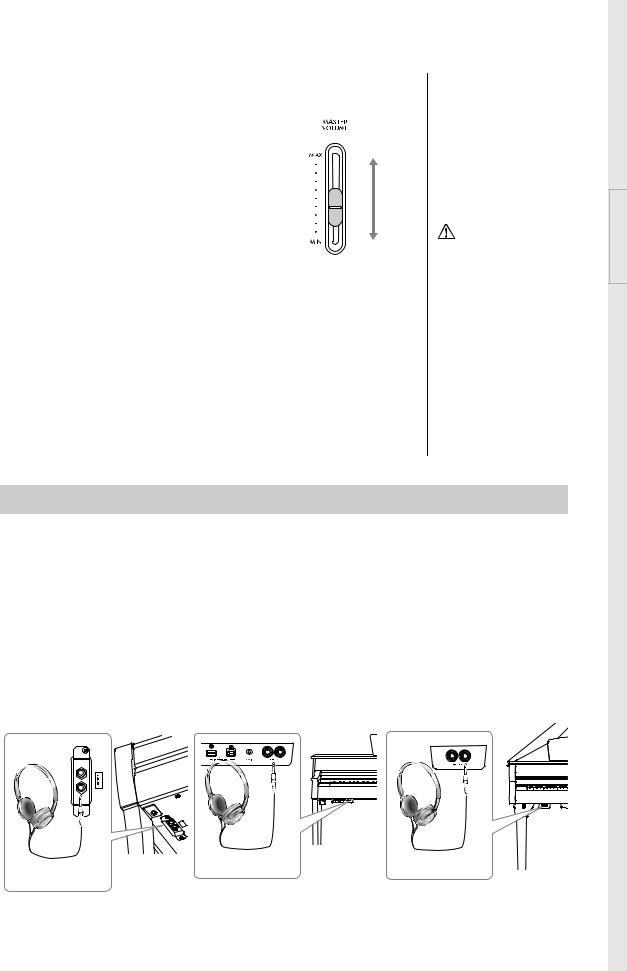
|
|
|
Getting Started — Playing the Clavinova |
|
|
|
|
|
|
|
|
Setting the Volume — [MASTER VOLUME] |
|
|
|
||
To adjust the volume, use the [MASTER VOLUME] |
|
|
|
Master Volume: The volume |
|
slider located at the right of the keyboard. Play the |
|
Increases |
|
level of the entire keyboard |
|
|
|
sound. |
|
||
keyboard to actually produce sound while you |
|
the level. |
|
Adjusting the [MASTER |
|
|
|
|
|
||
adjust the volume. |
|
|
|
VOLUME] slider also affects |
|
|
|
|
the output level of the |
|
|
|
|
|
|
[PHONES] jacks and the |
|
|
|
|
|
output level of the AUX OUT |
|
|
|
|
|
jacks. |
|
|
|
|
|
CAUTION |
|
|
|
Decreases |
|
Do not use the instrument for |
|
|
|
the level. |
|
a long period of time at a |
|
|
|
|
|
high or uncomfortable |
|
Intelligent Acoustic Control (IAC) |
|
|
|
volume level, since this can |
|
|
|
|
|||
|
|
|
cause permanent hearing |
|
|
|
|
|
|
|
|
|
|
|
|
loss. |
|
|
|
|
|
|
|
IAC is a function which automatically adjusts and controls the sound quality according to the overall volume of the instrument. Even when playing the instrument with the overall volume turned down, it permits both low sounds and high sounds to be clearly heard. IAC Control is effective only from the sound output of the instrument speakers.
You can set the IAC setting On or Off and its depth. For details, refer to “IAC” on page 98 and “IAC depth” on page 99. The default setting for this function is “On.”
Using Headphones
Connect a pair of headphones to one of the [PHONES] jacks. When the headphones are plugged into either of the [PHONES] jacks, the internal speaker system is automatically shut off. Two [PHONES] jacks are provided. Two sets of standard stereo headphones can be plugged in. (If you are using only one pair of headphones, you can plug them into either of these jacks.)
 CAUTION
CAUTION
Do not use the headphones for a long period of time at a high or uncomfortable volume level, since this can cause permanent hearing loss.
NOTE
•If you are using an adaptor plug, be sure to remove this as well when unplugging the headphones. No sound will come out of the instrument’s speakers if the adaptor plug is left connected.
•You can also hear sound through the speakers with the headphones plugged in. For details, refer to “Speaker” on page 100.
785 |
775 |
745 |
735 |
795GP 765GP |
|
785 |
775 |
745 |
735 |
795GP |
765GP |
|
785 |
775 |
745 |
735 |
795GP |
765GP |
Underside of keyboard
Standard stereo |
Standard stereo |
Standard stereo |
phone plug |
phone plug |
|
phone plug |
|
|
CLP-785, CLP-775, CLP-745, CLP-735, CLP-795GP, CLP-765GP Owner’s Manual 21

Getting Started — Playing the Clavinova
You can conveniently hang the headphones on the instrument when not using them. Install the headphone hanger by following the instruction at the end of this manual (CLP-785: page 119, CLP-775: page 122, CLP-745/735: page 125, CLP-795GP: page 129, CLP-765GP: page 133).
Reproducing the Natural Sensation of Sound Distance —Binaural Sampling and Stereophonic Optimizer
This instrument features two advanced technologies that allow you to enjoy exceptionally realistic, natural piano sound, even when listening on headphones.
Binaural Sampling
Binaural sampling is a method that uses two special microphones set at the ear position of a performer and records the sound from a piano as it is. Listening to the sound with this effect through headphones gives the impression of being immersed in the sound, as if it was actually emanating from the piano. When “CFX Grand” or “Bösendorfer” (page 26) is selected, connecting the headphones automatically enables binaural sampling sound.
Stereophonic Optimizer
The Stereophonic Optimizer is an effect which reproduces natural sound distance like the sound of binaural sampling even though you hear it on headphones. When any other Voice in the Piano group besides “CFX Grand” or “Bösendorfer” is selected, connecting the headphones automatically enables the Stereophonic Optimizer.
This function is turned on by default. Note that when the “Speaker” setting (page 100) is On, this function will always be disabled. Since these sounds are optimized for listening with headphones, we recommend that you set this function to “OFF” in the following situations.
•Playing the piano sound of this instrument with an external powered speaker system, while monitoring the sound output from this instrument on connected headphones.
•Making an audio recording (page 54) while using headphones, and then playing that recorded audio Song through speakers of this instrument. (Make sure to turn off these functions before audio recording.)
For details on setting this On or Off, refer to “Binaural” on page 99.
NOTICE
Do not hang anything other than the headphones on the hanger. Otherwise, the instrument or the hanger may be damaged.
Sampling
A technology which records the sounds of an acoustic instrument then stores them to the tone generator to be played based on information received from the keyboard.
NOTE
Voices in the Piano group are those contained in the “Piano” category in the Preset Voice List (page 106). For details about selecting Voices, refer to page 26.
NOTE
Before connecting an external powered speaker system, be sure to read “Connections” (page 71).
22 CLP-785, CLP-775, CLP-745, CLP-735, CLP-795GP, CLP-765GP Owner’s Manual

Getting Started — Playing the Clavinova
Using the Pedals
This instrument is equipped with three foot pedals: damper pedal (right), sostenuto pedal (center), and soft pedal (left).
Damper pedal (right pedal)
When you press the damper pedal, the notes you play have a longer sustain.
When you select a Voice in the Piano group, pressing the damper pedal activates the VRM (page 28) to accurately recreate the unique resonance of an acoustic grand piano’s soundboard and strings.
When you press the damper pedal here, the notes you play before you release the pedal have a longer sustain.
Half-pedal function
This instrument also has a Half-pedal function which allows you to use half-damper techniques, in which the damper is pressed somewhere between all the way down and all the way up. In this half-damper state (on a real piano), the damper felts only partially mute the strings. The Half-pedal function on the Clavinova lets you delicately and expressively control the damper muting, and create subtle nuances in your performance, by finely controlling the point at which pressure on the pedal affects the damper muting. For details on setting this, refer to “Half Pedal Point” on page 98.
GP Response Damper Pedal |
785 775 |
745 735 |
795GP |
765GP |
The damper pedal of the CLP-785, CLP-775 and CLP-795GP is the GP Response Damper Pedal. This special pedal has been designed to provide enhanced tactile response and, when pressed, is much closer in feel to the pedal of an actual grand piano. It makes it easier to physically experience the half-pedal point and more easily apply the half-pedal effect than other pedals. Since the pressing sensation may vary depending on the situation, including the location where the instrument is installed, you should adjust the half-pedal point described above to the desired setting.
Sostenuto pedal (center pedal)
If you play a note or chord on the keyboard and press the sostenuto pedal while holding the note(s), the notes will sustain as long as the pedal is held. All subsequent notes will not sustain.
Soft pedal (left pedal)
When you press the sostenuto pedal here while holding the note(s), the notes will sustain as long as you hold the pedal.
The soft pedal reduces the volume and slightly changes the timbre of notes played while the pedal is pressed. The soft pedal will not affect notes that are already playing when it is pressed. In order to apply this effect, play notes after pressing the pedal.
Keep in mind that this pedal function will be changed from the Soft pedal depending on the selected Voice. When the “Mellow Organ” is selected, pressing and releasing this pedal switches between “fast” and “slow” of the Rotary Speaker speed (“Rotary Speed” on page 88). When the “Vibraphone” is selected, this pedal switches Vibrato on and off (“VibeRotor” on page 88).
NOTE
Voices in the Piano group are those contained in the “Piano” category in the Preset Voice List (page 106). For details about selecting Voices, refer to page 26.
NOTE
You can assign other functions to each pedal by using “Pedal Assign” in “Voice” menu display (page 89).
NOTE
The pedals are covered with vinyl covers when shipped from the factory. If your instrument features the GP Response Damper Pedal, remove the cover from the damper pedal for optimum use of the pedal effect.
NOTE
While the sostenuto (center) pedal is held, a sustained (nondecaying) type of Voice such as strings or organ may sound continuously without decay after the notes have been released.
NOTE
The center pedal or left pedal can also be used as a [PLAY/ PAUSE] button. For details on the settings, refer to “Play/ Pause” on page 98.
CLP-785, CLP-775, CLP-745, CLP-735, CLP-795GP, CLP-765GP Owner’s Manual 23
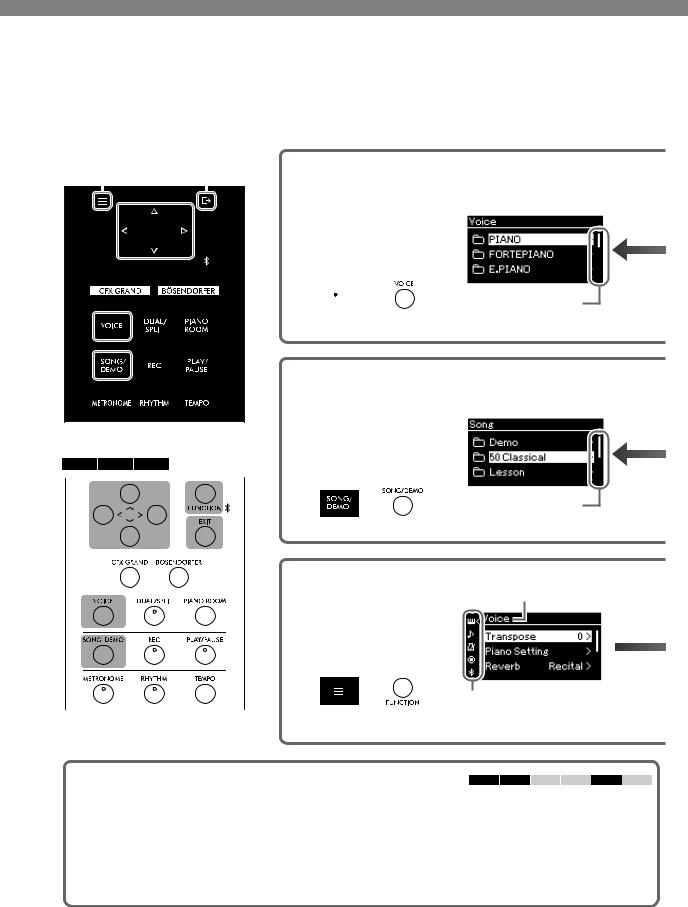
Basic Operations
On the screen display, you can call up three main functions: Voice, Song and Demo. In addition, various detailed settings can be made, for even greater playability and performance potential.
785 |
|
775 |
|
795GP |
|
|
|
|
|
|
FUNCTION |
|
|
EXIT |
Selecting Voices |
||||||
|
|
|
|
|
|
|
||||
|
|
|
|
|
|
|
1.Press the [VOICE] button |
|||
|
|
|
|
|
|
|
||||
|
|
|
|
|
|
|
|
to call up the Voice group |
||
|
|
|
|
|
|
|
|
list. |
||
|
|
|
|
|
|
|
|
|
|
|
|
|
|
|
|
|
|
|
|
|
|
|
|
|
|
|
|
|
|
|
|
|
2. Press the [u] or [d] button to select a Voice group.
When this is shown here, you can scroll through the display vertically.
Selecting Songs and
Demos
1. Press the [SONG/DEMO] button to call up the Song
category list.
745 735 765GP
2. Press the [u] or [d] button to select a Song category.
When this is shown here, you can scroll through the display vertically.
Detailed Settings (Menu display)
Menu name
1. Press the [FUNCTION] button repeatedly to select the desired menu.
Menu icon
The panel illustrations for CLP-735/745/765GP here and all those following are based on the CLP-745.
Changing the Control Panel Settings
785 |
775 |
745 |
735 |
795GP 765GP |
You can change the time that elapses until the control panel turns off, or you can set it to remain on indefinitely. You can also set the operation sound to off. For details, refer to “Auto Backlight Off” or “Touch Panel Sound” on page 101.
NOTICE
Do not operate the control panel using a sharp item, your fingernails or other hard objects. This may damage the control panel.
NOTE
You cannot operate the control panel by pressing two or more places at once.
24 CLP-785, CLP-775, CLP-745, CLP-735, CLP-795GP, CLP-765GP Owner’s Manual

Basic Operations
Voice: Instrument sound for playing from the keyboard. In addition to the Piano sounds, a wide variety of other musical instrument sounds are available.
Song: A piece of music for listening enjoyment or for playing back and practicing along with. Demo: Voice Demos let you experience the characteristics of the Voices.
[r] to select a Voice. [l] to return.
3.Press the [u] or [d] button to select a Voice.
4.Play the keyboard.
Voice display
[r] to select a Voice. [u] to return.
This indicates the current position in
the Voice group.
Press the [l] or [r] button to select the previous or next Voice.
3.Press the [u] or [d] button |
4.Press the [PLAY/PAUSE] button to |
playback the Song. |
|
to select a Song. |
Song display |
[r] to select a Song. |
[r] to select a Song. |
[l] to return. |
[u] to return. |
When “Lesson” is selected, |
Use the [l] or [r] button to select |
press the [u] or [d] button |
the previous or next bars. |
to select a Lesson type. |
|
2.Press the [u] or [d] button
to select a parameter. |
[r] to detailed settings. |
|
[EXIT] to return to the |
|
previous display. |
Note that the hierarchy depth differs depending on the selected parameter.
[r] to detailed settings. [l] to return.
Adjusting the value on the slider pop-up window
3. Press the [l] or [r] button to adjust the value, press the [EXIT] button to close the pop-up window.
Return to the Voice/Song display
Press the [EXIT] button to return to the Voice display or the Song display, depending on which display was previously shown.
While the pop-up window is shown, pressing the [EXIT] button returns to the previously shown display.
Selecting a value from a list
A checkmark is
 shown at the right of the selection.
shown at the right of the selection.
3. Use the [u][d] buttons or the [r] button to select a setting.
Press the [l] button to return to the previous display.
CLP-785, CLP-775, CLP-745, CLP-735, CLP-795GP, CLP-765GP Owner’s Manual 25
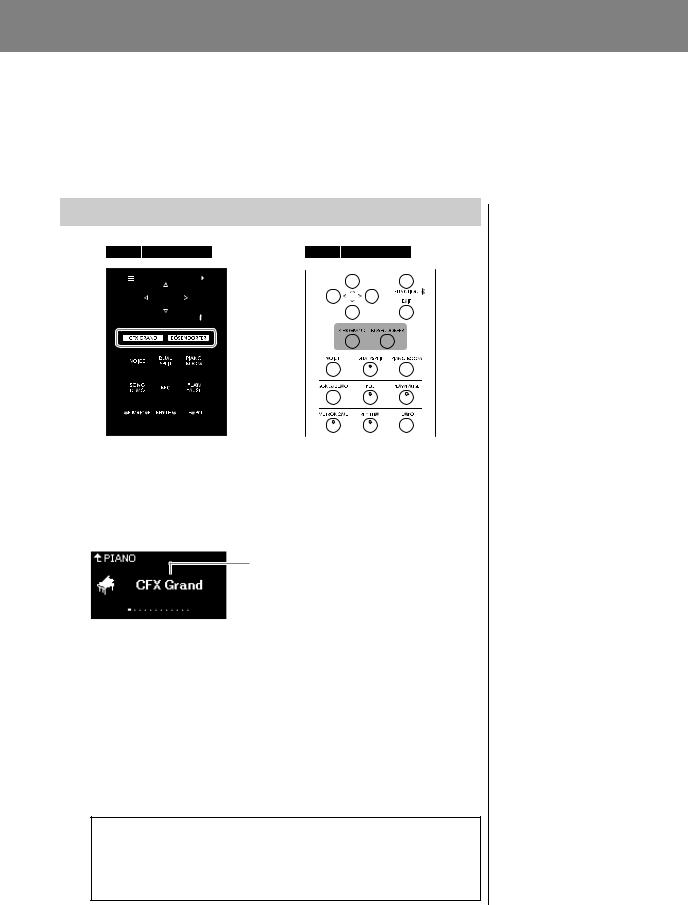
Main Operations
Enjoying the Piano Performance
This instrument puts the sounds of two renowned grand pianos, the Yamaha CFX and Bösendorfer Imperial, as well as other piano sounds—each with its own distinctive appeal and sonic characteristics. Simply select the particular piano sound desired, according to the music you intend to play or your personal preferences.
Selecting two Grand Piano Voices from the panel directly
785 |
775 |
795GP |
745 |
735 |
765GP |
1. Press the [CFX GRAND] button or the [BÖSENDORFER] button to select the piano type.
A Voice is called up from the selected Voice button and its name appears on the Voice display.
Voice display
Voice name
CFX Grand
Yamaha’s CFX concert grand piano sound with a wide dynamic range for maximum expressive control. Suitable for playing in any music genre and style.
Bösendorfer
The famed sound of the Vienna-made Bösendorfer Imperial concert grand piano. Its spacious sound evokes the size of the instrument, and is ideal for expressing tenderness in compositions.
2. Play the Keyboard.
Selecting Other Piano Voices
Press the [l][r] buttons to select other piano Voices than “CFX Grand” and “Bösendorfer.” You can also select the other Voices by pressing the [VOICE] button (page 30).
NOTE
You can hear and experience the characteristics of the Voices by listening to the Demo Songs for each Voice
(page 32).
26 CLP-785, CLP-775, CLP-745, CLP-735, CLP-795GP, CLP-765GP Owner’s Manual
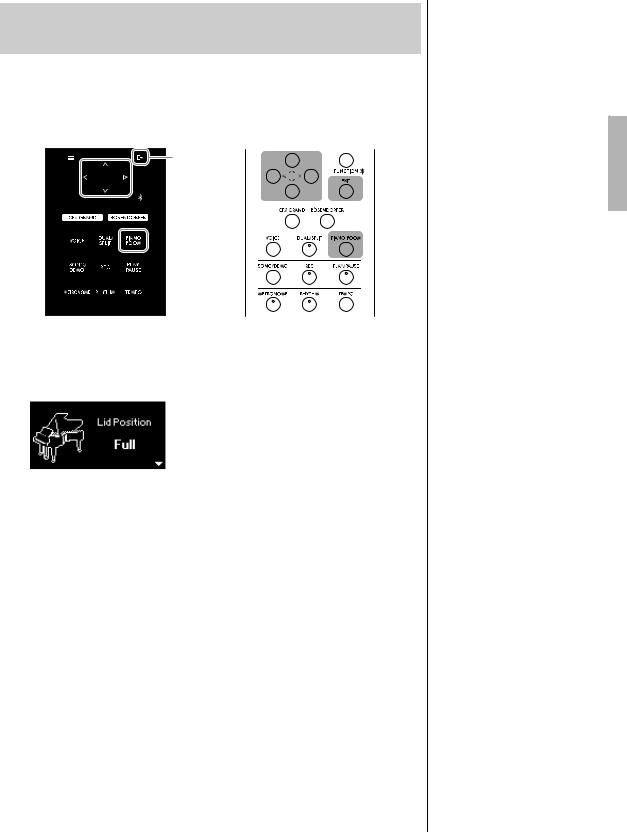
Enjoying the Piano Performance
Customizing the Sound and the Touch Response of Piano Voices (Piano Room)
You can adjust the detailed settings of Voices in the Piano group in the Piano Room. Try creating a custom piano sound by adjusting the various parameters such as lid position, string resonance, damper resonance and so on.
785 |
|
775 |
|
795GP |
|
745 |
|
735 |
|
765GP |
EXIT
1. Press the [PIANO ROOM] button to call up the Piano
Room display.
Piano Room display
2. Press the [u]/[d] buttons to select items (page 28).
3. Press the [l]/[r] buttons to change the settings (page 28).
4. Press the [EXIT] button to exit from the Piano Room display.
NOTE
Voices in the Piano group are those contained in the “Piano” group in the Preset Voice List on page 106.
NOTE
If a Voice other than one in the Piano group is selected, pressing the [PIANO ROOM] button changes it to “CFX Grand.”
NOTE
Pressing the [PIANO ROOM] button disables the Dual/Split/ Duo functions.
CLP-785, CLP-775, CLP-745, CLP-735, CLP-795GP, CLP-765GP Owner’s Manual 27

Enjoying the Piano Performance
Parameters you can set in the Piano Room
|
Item |
Icon |
Description |
Default |
Setting Range |
|
setting |
||||
|
|
|
|
|
|
Lid Position |
|
Recreates the differences in sound depending on how high |
Full |
Full, Half, |
|
|
|
|
the (virtual) grand piano lid is opened. |
|
Closed |
|
|
|
|
|
|
Brightness |
|
Adjusts the brilliance of sound. |
Differs |
0 – 10 |
|
|
|
|
|
depending on |
|
|
|
|
|
the Voice. |
|
|
|
|
|
|
|
Touch |
|
Determines how the sound responds to your playing |
Medium |
Soft2, Soft1, |
|
|
|
|
strength. You should adjust this setting according to the |
|
Medium, Hard1, |
|
|
|
specific Voice you’re playing or the particular Song you’re |
|
Hard2, Fixed |
|
|
|
performing, as desired. |
|
|
|
|
|
|
|
|
Reverb |
|
Determines the Reverb type which is applied to all the entire |
Differs |
Refer to the |
|
|
|
|
sound including the keyboard performance, Song playback |
depending on |
Reverb Type |
|
|
|
and MIDI data input from an external MIDI device. |
the Voice. |
List (page 90) |
|
|
|
|
|
|
|
Reverb |
|
Adjusts the Reverb depth. When “Reverb” is set to “off” or a |
Differs |
0 – 40 |
|
Depth |
|
value of “0,” no effect is produced. |
depending on |
|
|
|
|
|
the Voice. |
|
|
|
|
|
|
|
Master Tune |
|
Fine tunes the pitch of the entire instrument. This function is |
A3 = 440.0 Hz |
A3 = 414.8 Hz – |
|
|
|
|
useful when you play this instrument along with other |
|
466.8 Hz |
|
|
|
instruments or CD music. |
|
(approx. 0.2 Hz |
|
|
|
|
|
steps) |
|
|
|
|
|
|
VRM |
|
Turns the VRM effect on/off. For information about the VRM |
On |
On, Off |
|
|
|
|
function, refer to page 29. |
|
|
|
|
|
Listening to the VRM Demo |
|
|
|
|
|
Press the [PLAY/PAUSE] button |
|
|
|
|
|
while this display is open to play |
|
|
|
|
|
back the VRM Demo Song. You |
|
|
|
|
|
can hear the Demo Song with and |
|
|
|
|
|
without the effect (VRM on or off). |
|
|
|
|
|
The five parameters below can be set when “VRM” is On. |
|
|
|
|
|
|
|
|
|
Damper |
|
Determines the depth of the string resonance effect which is |
5 |
0 – 10 |
|
Resonance |
|
applied when the damper pedal is pressed. |
|
|
|
|
|
|
|
|
|
Damper |
|
Turns the Damper Noise produced by the VRM function On/ |
On |
On, Off |
|
Noise |
|
Off. For details on damper noise, refer to page 29. This |
|
|
|
|
|
function will be disabled when “Damper Resonance” is set to |
|
|
|
|
|
“0.” |
|
|
|
|
|
|
|
|
|
String |
|
Determines the depth of the string resonance effect which is |
5 |
0 – 10 |
|
Resonance |
|
applied when a note on the keyboard is pressed. |
|
|
|
|
|
|
|
|
|
Duplex Scale |
|
Adjusts the sympathetic vibrations of the duplex scaling |
5 |
0 – 10 |
|
Resonance |
|
resonance effect in VRM. For details about duplex scaling, |
|
|
|
|
|
refer to “What is Duplex Scale?” (page 29). |
|
|
|
|
|
|
|
|
|
Body |
|
Adjusts the resonance of the piano itself (the soundboard, |
5 |
0 – 10 |
|
Resonance |
|
the sides, the frame and so on) in VRM. |
|
|
|
|
|
|
|
|
28 CLP-785, CLP-775, CLP-745, CLP-735, CLP-795GP, CLP-765GP Owner’s Manual
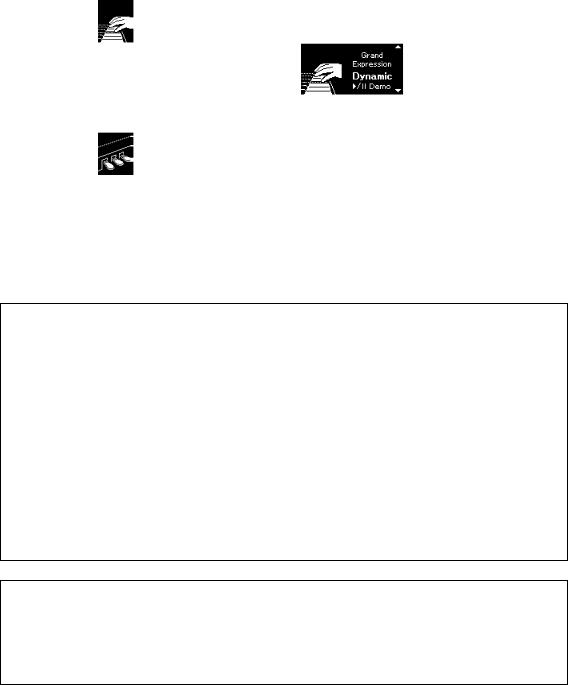
Enjoying the Piano Performance
Item |
Icon |
Description |
Default |
Setting Range |
|
|
setting |
|
|
||||
|
|
|
|
|
|
|
Grand Expression |
|
Selects the type of the Grand Expression Modeling effects, |
Dynamic |
Dynamic, Static |
|
|
|
|
which simulates the physical sound transitions of an actual |
|
|
|
|
|
|
piano. When this feature is set to “Dynamic,” you can control |
|
|
|
|
|
|
extremely subtle nuances in the performance and sound by |
|
|
|
|
|
|
changing your playing strength or touch. When set to |
|
|
|
|
|
|
“Static,” the nuances are generally fixed. For details about |
|
|
|
|
|
|
Grand Expression Modeling, refer to the below. |
|
|
|
|
|
|
NOTE |
|
|
|
|
|
|
|
|
|
|
|
|
|
Grand Expression Modeling is effective only for the Voices of |
|
|
|
|
|
|
“CFX Grand” and “Bösendorfer.” |
|
|
|
|
|
|
Listening to the Demo |
|
|
|
|
|
|
Press the [PLAY/PAUSE] button |
|
|
|
|
|
|
while this display is open to play |
|
|
|
|
|
|
back the Demo Song of this |
|
|
|
|
|
|
function. You can listen to the |
|
|
|
|
|
|
Demo song with “Dynamic” or |
|
|
|
|
|
|
|
|
|
|
|
|
|
“Static.” |
|
|
|
|
|
|
|
|
|
|
|
Half Pedal Point |
|
Specify the point to which you must depress the right pedal |
0 |
-2 (effective with |
|
|
|
|
before the effect of “Sustain Continuously” begins to be |
|
the shallowest |
|
|
|
|
applied. This setting applies only to the “Sustain |
|
press) – 0 – +4 |
|
|
|
|
Continuously” effect (page 91) that is assigned to the right |
|
(effective with |
|
|
|
|
pedal. |
|
the deepest |
|
|
|
|
|
|
press) |
|
|
|
|
|
|
|
|
|
NOTE
•If you wish to keep the Piano Room settings even after turning off the power, set “Voice” and “Other” in the “Backup” setting to “On.” For details, refer to page 104.
•The items listed above can also be set in the “Voice” menu display (page 87) or the “System” menu display (page 97). When you change these settings in the Piano Room display, the settings in the menu displays will also be changed. Conversely, changing the settings in the menu displays will also change the settings in the Piano Room display.
What is VRM?
The VRM (Virtual Resonance Modeling) function uses sophisticated physical modeling to simulate the actual string resonance sound that occurs when the damper pedal on a real piano is pressed or keys are played and held.
On an actual acoustic piano, if you press the damper pedal and play a key, not only does the string of the pressed key vibrate, it also causes other strings and the soundboard to vibrate, each influencing the rest and creating a rich and brilliant resonance that sustains and spreads. The VRM (Virtual Resonance Modeling) technology featured in this instrument reproduces the complicated interaction of both string and soundboard resonance faithfully using a virtual musical instrument (physical modeling), and makes the sound more like a real acoustic piano. Since instantaneous resonance is made at the moment according to the state of the keyboard or pedal, you can vary the sound expressively by changing the timing of your pressing the keys, and the timing and depth of your pressing the pedal.
What is Duplex Scale?
Duplex scaling is a stringing method for pianos that uses extra, un-struck strings in the upper octaves to enhance the tone. These strings sympathetically vibrate with other strings in an acoustic piano, resonating with overtones, and adding richness, brilliance and complex color to the sound. Since they do not have a damper, they will continue sounding even after you release your hands from the keyboard.
What is Damper Noise?
Damper noise is the sound made on an acoustic piano when the damper pedal is pressed. The damper noise changes in tone and volume depending on how quickly the damper pedal is pressed down. Pressing the damper pedal slowly will make a quieter sound when the damper heads are released from the strings. Pressing the damper pedal with force will transmit the vibrations to the strings, which adds a lower and louder sound.
What is Grand Expression Modeling?
On an actual acoustic piano, subtle changes in the sound can be produced by changing your playing touch from when you press a key to when you release it. For example, when you press a key all the way to its bottom, the key hits the keybed underneath and the noise reaches the strings, changing the sound slightly. Furthermore, the tone when the damper is lowered onto strings to mute the sound is changed by how quickly you release the key. The Grand Expression Modeling technology recreates these subtle changes in the sound that respond to your touch. This allows you to add accents by playing strongly or add resonance by playing softly to produce superbly expressive sound. A crisp tone can be heard when playing staccato as well as a lingering sound produced when releasing the keys slowly.
CLP-785, CLP-775, CLP-745, CLP-735, CLP-795GP, CLP-765GP Owner’s Manual 29

Playing Various Musical Instrument Sounds (Voices)
In addition to the wonderfully realistic piano sounds, you can select and play other musical instrument sounds (Voices), such as organ or stringed instruments. You can also select authentic Voices of fortepianos, which were made in 18th and 19th centuries.
Selecting Voices
The Voices of the instrument are conveniently divided into groups of instrument types. Select a desired Voice and play the keyboard.
You can also select a Voice from the XG Voices (CLP-785 and CLP-795GP only). For instructions, refer to page 31.
785 |
|
775 |
|
795GP |
|
|
745 |
|
735 |
|
765GP |
|
|
|
|
|
|
|
|
|
|
|
|
|
|
|
|
|
|
|
|
|
|
|
|
|
|
|
|
|
|
|
|
|
|
|
|
|
|
|
|
|
|
|
|
|
|
|
|
|
|
|
|
|
|
|
|
|
|
1. Press the [VOICE] button to call up the Voice group list.
Voice groups are listed in the display. The currently selected Voice group is highlighted.
Voice group list
Voice group
2. Use the [u]/[d] buttons to select the Voice group.
Highlight the Voice group name you want to use.
NOTE
To hear and experience the characteristics of the Voices, listen to the Demo Songs for each Voice (page 32).
NOTE
Touch Response will not be applied to some Voices. For information about the Voices to which Touch Response can be applied, refer to the “Preset Voice List” on page 106.
XG
XG is a major enhancement of the GM System level 1 format (page 43), and was developed by Yamaha specially to provide more Voices and variations, as well as greater expressive control over Voices and effects, and to ensure compatibility of data well into the future.
NOTE
For information about the Voices, refer to the “Preset Voice List” (page 106).
30 CLP-785, CLP-775, CLP-745, CLP-735, CLP-795GP, CLP-765GP Owner’s Manual
